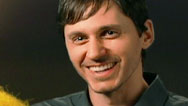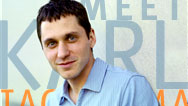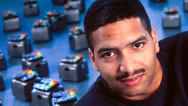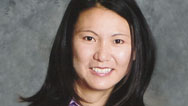Profile: Karl Iagnemma
- Posted 09.03.06
- NOVA scienceNOW
(This video is no longer available for streaming.) Karl Iagnemma gives new meaning to the notion of the "bookish scientist" (or, in his case, engineer). In addition to working with a team of MIT researchers who are designing robots for NASA, he is also a breakout fiction writer. Brad Pitt has optioned Iagnemma's short story collection for possible feature film development, and his first novel is generating high interest. Smashing the stereotype of the brainy, bespectacled researcher toiling away in a laboratory, Iagnemma illustrates how science and creativity are linked, and how imagination is the key to innovation in any discipline.
Transcript
PROFILE: KARL IAGNEMMA
PBS Airdate: October 3, 2006
NEIL DEGRASSE TYSON: We all know the popular image of artists: painters, writers, performers, they're creative but undisciplined; and then there's the scientist: analytical, methodical, obsessed with accuracy. But whether these clichés are right or wrong, sometimes the artist and the scientist are more alike than you think. Check out this guy.
KARL IAGNEMMA (Artist/Scientist): "At the sound of Marya's name, a shiver began in Henderson's chest that scurried over every inch of his skin. He felt as though he had been heated over glowing coals, then dunked into an ocean-sized bath of ice water."
NEIL DEGRASSE TYSON: Meet Karl...
KARL IAGNEMMA: Karl Iagnemma.
NEIL deGRASSE TYSON: Iagnemma?
KARL IAGNEMMA: Iagnemma, yup. It's Italian.
NEIL DEGRASSE TYSON: He's a successful writer of fiction, but he's also the same person who's been called one of the top 10 innovative scientists of America. How can he be both?
His father was Emidio Iagnemma. Born in Italy, he came to Detroit, and he raised his son to be just like him, an engineer.
KARL IAGNEMMA: I ended up following pretty closely in his footsteps. We shared, definitely, an interest and a love for physics and math.
CATHERINE IAGNEMMA (Karl's Sister): I always knew he had a mind like my, like my father. They used to go to computer clubs together, you know, exchange software, and he took drafting classes.
NEIL DEGRASSE TYSON: And Karl did some experimenting when his father wasn't looking.
KARL IAGNEMMA: Friends and I would do various experiments with combustion, but nothing too serious, no felonies.
KATHERINE IAGNEMMA: He would, like, light tennis balls on fire and throw them down the driveway.
KARL IAGNEMMA: Uh oh. I knew I shouldn't have given you her name.
NEIL DEGRASSE TYSON: But all those experiments clearly paid off because Karl went to MIT, where he stayed on to earn his PhD in mechanical engineering and is now a principal research scientist. And today, he's a top member of a team of researchers who are designing robots smart enough to understand their environment. Their algorithms will make it easier for robots to navigate through truly difficult terrain, and enable NASA to explore parts of Mars scientists can only dream of reaching today.
KARL IAGNEMMA: Robots right now are pretty dumb. They have a hard time understanding if something is a bush compared to a stone. For wheeled robots, the danger is always that you're going to drive somewhere, think it's a safe place to drive, and you end up getting stuck. And on Mars, you know, you can't call AAA to tow you out.
PAUL SCHENKER (NASA/Jet Propulsion Laboratory): As a researcher, I think Karl brings some of the best qualities you look for.
NEIL DEGRASSE TYSON: Paul Schenker manages the Robotics Space Exploration Technology Program, for NASA, at the Jet Propulsion Labs, in Pasadena. NASA awarded Team MIT more than a million dollars for research overseen, day to day, by Karl.
PAUL SCHENKER: He's very objective, patient, thoughtful in framing his problems. He also brings passion to his work.
NEIL DEGRASSE TYSON: But which work? Let's go back.
Meet the other Karl.
KATHERINE IAGNEMMA: Iagnemma; it rhymes with dilemma.
NEIL DEGRASSE TYSON: His mother, Patricia Iagnemma, was an English major.
KATHERINE IAGNEMMA: My mother loved literature, so we had books in every room—in the laundry room, in the family room. Karl would lock himself in his room and just read and read and read.
NEIL DEGRASSE TYSON: Karl could also write. In fact, his minor at MIT was in writing, fiction writing, which confused one of his advisors.
KARL IAGNEMMA: He said, "Oh, I thought you were studying friction."
NEIL DEGRASSE TYSON: Hard to believe, but true. Also true is that Karl's short story won a contest for fiction writing—not friction writing—held by Playboy magazine, in 1998. And while he was writing his PhD thesis, he started to write his first book.
KARL IAGNEMMA: And I finished it the week after I finished my PhD thesis.
NEIL DEGRASSE TYSON: On the Nature of Human Romantic Interaction is meant to sound like a thesis, but don't be fooled. It's an award winning collection of short stories about characters—many of them scientists, by the way—who fall in and out of love. Karl proves wrong the old assumption that science guys can only write science fiction.
KATHERINE IAGNEMMA: I always refer to him as being whole-brained, using the totality of his brain. I see the dedication that he uses in science applied to his writing.
STEVE ALMOND (Author, My Life in Heavy Metal, Candyfreak): I just...I don't think I know anybody who's, certainly, at that high a level in both those areas. It's rare.
NEIL DEGRASSE TYSON: Now, it would be easy to congratulate Karl for using more of his brain than most of us, which he clearly does. And it would be a little too easy to marvel at how Karl has managed to succeed at two professions that would seem to be complete opposites: science and fiction writing. But, as it turns out, some of the very same skills Karl uses in scientific exploration come to his aid in, well, making stuff up.
KARL IAGNEMMA: In each discipline, you start with a blank page. You start with an idea. There are so many parallels between writing and research. I mean, I view each process as one of increasingly structured creativity.
NEIL DEGRASSE TYSON: Okay, so both a writer and a researcher have to be creative, but just ask any writer or any scientist, and they'll tell you creativity is meaningless without discipline. Before you can stare at a blank page or screen, you must get your butt to the chair, and Karl does it day in, day out.
KARL IAGNEMMA: A lot of writing is just passing the time until something good comes along, and you don't know when that'll be. So, to be safe, you should be in that chair as much as you can, on the off chance that, you know, a miracle will happen and the story will be born.
ANKI IAGNEMMA (Karl's Wife): For Karl, it's a lot about patience and discipline. That's an important part of his process, I think. He does his hours whether he gets 10 pages or one paragraph.
KARL IAGNEMMA: A lot of times, I'm in the chair, in the evening or in the early morning, with my earplugs in, so that I can hear all the characters' voices, and just typing either nonsense, or typing an outline of a story, or typing dialogue that may be good, may be not any good. But when the story comes along, and when you get that germ, that little spark, and you feel it, and you know it, that's when the actual story writing process truly starts.
STEVE ALMOND: He's really efficient. He believes he's inefficient. "Oh, it's takes me so long to write." You write so quickly. And I'm like, "Dude, I'm not going to a lab trying to figure out how to get the machine to go over the big rock on mars, okay? I'm not even...I'm having difficulty unloading the dishwasher, okay?"
ALAN LIGHTMAN (Author, Einstein's Dreams, Good Benito and Physicist): Both writing fiction and doing scientific research are pretty much fulltime jobs. They're jobs that occupy you 24 hours a day. You're not a very good friend, lover, husband, wife during this period of months that you're consumed by a scientific problem. You're not very much fun to be around.
ANKI IAGNEMMA: I definitely feel that Karl is with me when he's with me, but I do think that he thinks about his work all the time. Since we moved in together, and definitely since Sofia came, he has to be more structured in his work, and he has to set aside hours more. And I think he does that really well, and that's...and he does that in a very focused way.
NEIL DEGRASSE TYSON: But that structure, those hours, that's a lot of time spent alone.
KARL IAGNEMMA: Solitude is something, as a writer and a researcher, you have to be comfortable with. Writing is, you know, really solitary, and research is, kind of, its little brother.
ALAN LIGHTMAN: When you're solving the equations, you're usually alone weeks and months. I mean, you will, you'll stop to eat meals.
STEVE ALMOND: The great untold secret about writing is that it's incredibly lonely. You cannot do it—I can't do it, anyway—with other people around.
KARL IAGNEMMA: And you have to be okay with that. Some people could never be okay with that. They just wouldn't enjoy the work, because they would miss the human contact, or they would miss various aspects of being out in the world.
STEVE ALMOND: If I show up at my poker game, and I've spent the day writing, or trying to write, immediately my poker buddies are like...'cause I'm like, "Hey, how are you doing, guys? All right, what are we...?" And they're like, "Have you spoken to anyone today? You know, have you talked with anybody?" They know that like, "Uh oh, crazy, lonely guy...here he is."
NEIL DEGRASSE TYSON: It's hardly a rational way to live.
ALAN LIGHTMAN: Scientists are passionate about their work. They do it because they cannot not do it.
KARL IAGNEMMA: You get this little rush. You enter into this state where the time just seems to pass. It's just the best feeling. And that's why you want to go back the next day and do it again, because of that feeling.
NEIL DEGRASSE TYSON: But can that feeling carry Karl through two intense careers? Alan Lightman chose to give up his research career in physics to become a successful novelist.
ALAN LIGHTMAN: Both the science and the fiction writing are addictions. At some point, if he wants to be a scientist and he wants to be a novelist, one of those powerful forces is going to conquer the other one.
KARL IAGNEMMA: "They met as first year graduate students at the Michigan Engineering Institute, two aggressive young theorists who disagreed about Marx and Irish beer, but agreed that mathematics was a game, the most elaborate, wonderful game, like puzzling out riddles posed by God."
Right now, I'm happy doing both. It's, it's tiring. It's fairly exhausting, but it's satisfying. It's kind of the feeling after, I imagine, after a runner has completed a long run. It's that pleasant satisfied exhaustion. That's kind of my constant state.
Thank you very much.
NEIL DEGRASSE TYSON: Exhausted and passionate, disciplined and humble, Karl Iagnemma will continue to write and calculate using his entire brain. But to his friends, he's just plain old Karl, the walking algorithm for success.
STEVE ALMOND: If it were me, if I was doing this stuff, I would be like, "Dude, I've got a robot going to mars. What did you do yesterday? And that was before lunch. Then I wrote a great short story in the afternoon. Then I hung out with my beautiful Swedish wife. What'd you do?"
NEIL DEGRASSE TYSON: If that's not enough: the movie rights to one of Karl's short stories have been optioned by Hollywood to be produced by Brad Pitt.
Credits
Profile: Karl Iagnemma
- Edited by
- Robe Imbriano
- Produced by
- Robe Imbriano & Carla Denly
NOVA scienceNOW
- Executive Producer
- Samuel Fine
- Executive Editor
- Neil deGrasse Tyson
- Senior Series Producer
- Vincent Liota
- Supervising Producer
- Stephen Sweigart
- Development Producer
- Vinita Mehta
- Program Editor
- David Chmura
- Associate Producers
- Win Rosenfeld
Anthony Manupelli
Mica McCarthy
Shimona Shahi
Mary Robertson
Shannon Guirl
Courtney Kline - Unit Manager
- Candace White
- Production Secretary
- Fran Laks
- Animator
- Brian Edgerton
- Music
- Rob Morsberger
- Song: "The Elements" Music and Lyrics by
- Tom Lehrer
- NOVA scienceNOW Series Animation
- Edgeworx
- Camera
- Vincent Liota
Peter Bonilla
Mike Coles
Brian Dowley
Anthony Forma - Sound Recordists
- Adriano Bravo
John Cameron
Michael Karas
John O'Connor
Keith Rodgerson
Allen Stith - Audio Mix
- John Jenkins
- Colorist
- Mark Steele
- Animation
-
Vincent Liota
Sputnik - Animation
- Three-dimensional animations courtesy of LONI and the Center for Computational Biology in collaboration with the National Institutes of Mental Health. Principal Investigator: Arthur W. Toga, Animators: Ken Nakada, Tomokatsu Shoji, Hideo Kumagai, Amanda Hammond, Kim Hager, Andrew Lee & John Bacheller
- Special Thanks
- Software Bisque
- Archival Material
- Allen Friensehner/LLNL
Joint Institute for Nuclear Research at Dubna
Maas Digital LLC
NASA /Jet Propulsion Laboratory
NASA/JPL/Cornell
Aerial shot of JPL courtesy NASA/JPL-Caltech
Jennifer Hulshizer/Star Ledger/Corbis - Archival Playboy Magazine material provided by Playboy. Used with Permission. All rights reserved.
- NOVA Series Graphics
- yU + co.
- NOVA Theme Music
- Walter Werzowa
John Luker
Musikvergnuegen, Inc. - Additional NOVA Theme Music
- Ray Loring
- Post Production Online Editors
- Spencer Gentry
Mark Steele - Closed Captioning
- The Caption Center
- NOVA Administrator
- Dara Bourne
- Publicity
-
Eileen Campion
Olivia Wong - Researcher
- Gaia Remerowski
- Production Coordinator
- Linda Callahan
- Unit Managers
- Carla Raimer
Karen Lally - Paralegal
- Raphael Nemes
- Legal Counsel
- Susan Rosen Shishko
- Post Production Assistant
- Josh Thurston
- Assistant Editor
- Alex Kreuter
- Associate Producer, Post Production
- Patrick Carey
- Post Production Supervisor
- Regina O'Toole
- Post Production Editor
- Rebecca Nieto
- Post Production Manager
- Nathan Gunner
- Producer, Special Projects
- Susanne Simpson
- Coordinating Producer
- Laurie Cahalane
- Senior Science Editor
- Evan Hadingham
- Senior Series Producer
- Melanie Wallace
- Managing Director
- Alan Ritsko
- Senior Executive Producer
- Paula S. Apsell
This material is based upon work supported by the National Science Foundation under Grant No. 0229297. Any opinions, findings, and conclusions or recommendations expressed in this material are those of the author(s) and do not necessarily reflect the views of the National Science Foundation.
NOVA scienceNOW is a trademark of the WGBH Educational Foundation.
NOVA scienceNOW is produced for WGBH/Boston by NOVA.
© 2006 WGBH Educational Foundation
All rights reserved
- Image credit: (Karl Iagnemma) © Tracy Powell
Participants
- Steve Almond
- Author www.stevenalmond.com/
- Anki Iagnemma
- Karl's wife
- Catherine Iagnemma
- Karl's sister
- Karl Iagnemma
- MIT robots.mit.edu/people/Karl/karl.html
- Alan Lightman
- Author & Physicist www.mit.edu/~humanistic/faculty/lightman.html
- Paul Schenker
- Jet Propulsion Laboratory
Related Links
-

Karl Iagnemma: Expert Q&A
Karl Iagnemma offers career advice to aspiring scientist/writers, answers questions about writing fiction, and more.
-

The Dual Life of Karl Iagnemma
A robot-building engineer and fiction writer talks about the creativity and discipline in both of his careers.
-

Meet Karl Iagnemma
Hear the roboticist/fiction writer answer questions about his two trades.
-

Profile: James McLurkin
Engineer James McLurkin designs robot "swarms"—groups of robots that work together for a greater purpose.
-

Profile: Yoky Matsuoka
A former tennis prodigy aims to create advanced prosthetic limbs controlled by human thought.



